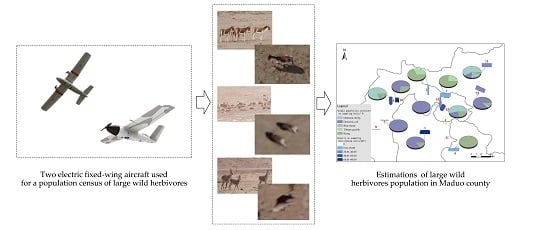Application of UAV Remote Sensing for a Population Census of Large Wild Herbivores—Taking the Headwater Region of the Yellow River as an Example
Abstract
1. Introduction
2. Materials and Methods
2.1. Study Area
2.2. UAV Survey and Image Recognition
2.2.1. UAV Survey
2.2.2. Image Recognition and Quality Control
2.3. Ground Surveys
2.4. Population Estimation
3. Results
3.1. Large Wild Herbivores and Livestock Populations
3.1.1. Population and Group Size in the UAV Survey Transects
3.1.2. Large Wild Herbivore Populations in Maduo County
4. Discussion
5. Conclusions
Author Contributions
Funding
Acknowledgments
Conflicts of Interest
References
- Liu, J.Y.; Xu, X.L.; Shao, Q.Q. Grassland degradation in the “Three-River Headwaters” region, Qinghai Province. Acta Geogr. Sin. 2008, 64, 364–367. [Google Scholar] [CrossRef]
- Wu, Y.; Dong, S.-K.; Zhang, X.-F.; Liu, Y.-H.; Shi, J.-B.; Zhang, X.; Su, X.-K.; Wang, X.-X.; Li, Y.-Y.; Beijing Normal University; et al. Summer Habitat Selection of the Ungulates Equus kiang and Bos grunniens in Altun Mountain Reserve. Chin. J. Zool. 2014, 49, 317–327. [Google Scholar]
- Dawson, M.J.; Miller, C. Aerial mark–recapture estimates of wild horses using natural markings. Wildl. Res. 2008, 35, 365–370. [Google Scholar] [CrossRef]
- Melville, G.J.; Tracey, J.P.; Fleming, P.J.S.; Lukins, B.S. Aerial surveys of multiple species: critical assumptions and sources of bias in distance and mark–recapture estimators. Wildl. Res. 2008, 35, 310–348. [Google Scholar] [CrossRef]
- Fewster, R.M.; Pople, A.R. A comparison of mark–recapture distance-sampling methods applied to aerial surveys of eastern grey kangaroos. Wildl. Res. 2008, 35, 320–330. [Google Scholar] [CrossRef]
- Zhao, H.T.; Wang, C.L.; Wang, X.W.; LI, B.G.; Wang, K.F.; LI, T.C.; Li, J.F.; Gao, C.L. Distribution and population status of Macaca mulatta in Shaanxi Micangshan National Reserve. Acta Ecol. Sin. 2015, 35, 5632–5637. [Google Scholar]
- Liu, S.L.; Zhao, H.D.; Dong, S.K.; Su, X.K.; Liu, Q.; Deng, L.; Zhang, X.; Beijing Normal University; Administration of Altun Mountain National Nature Reserve. Dynamic of Vegetation in the Altun Mountain Nature Reserve Based on SPOT NDVI. Arid Zone Res. 2014, 31, 832–837. [Google Scholar]
- Su, X.K.; Dong, S.K.; Liu, S.L.; Liu, Y.H.; Shi, J.B.; Wu, Y.; Zhang, X.; Xu, D.H. Effects of land use/land cover change (LUCC) on habitats of Tibetan wild donkey in Aerjin Mountain Nature Reserve. Chin. J. Ecol. 2014, 33, 141–148. [Google Scholar]
- Viña, A.; Bearer, S.; Zhang, H.; Ouyang, Z.; Liu, J. Evaluating MODIS data for mapping wildlife habitat distribution. Remote Sens. Environ. 2008, 112, 2160–2169. [Google Scholar] [CrossRef]
- Ito, T.Y.; Miura, N.; Lhagvasuren, B.; Enkhbileg, D.; Takatsuki, S.; Tsunekawa, A.; Jiang, Z. Satellite tracking of Mongolian gazelles (Procapra gutturosa) and habitat shifts in their seasonal ranges. J. Zool. 2006, 269, 291–298. [Google Scholar] [CrossRef]
- Ottichilo, W.K.; Leeuw, J.D.; Prins, H.H.T. Population trends of resident wildebeest [Connochaetes taurinus hecki, (Neumann)] and factors influencing them in the Masai Mara ecosystem, Kenya. Biol. Conserv. 2001, 97, 271–282. [Google Scholar] [CrossRef]
- Georgiadis, N.J.; Olwero, J.N.; Romañach, S.S. Savanna herbivore dynamics in a livestock-dominated landscape: I. Dependence on land use, rainfall, density, and time. Biol. Conserv. 2007, 137, 461–472. [Google Scholar] [CrossRef]
- Stoner, C.; Caro, T.I.M.; Mduma, S.; Mlingwa, C.; Sabuni, G.; Borner, M. Assessment of Effectiveness of Protection Strategies in Tanzania Based on a Decade of Survey Data for Large Herbivores. Conserv. Biol. 2007, 21, 635–646. [Google Scholar] [CrossRef] [PubMed]
- Ogutu, J.O.; Owen-Smith, N.; Piepho, H.P.; Said, M.Y. Continuing wildlife population declines and range contraction in the Mara region of Kenya during 1977–2009. J. Zool. 2011, 285, 99–109. [Google Scholar] [CrossRef]
- Chabot, D.; Bird, D.M. Wildlife research and management methods in the 21st century: Where do unmanned aircraft fit in? J. Unmanned Veh. Syst. 2015, 3, 137–155. [Google Scholar] [CrossRef]
- Linchant, J.; Lisein, J.; Semeki, J.; Lejeune, P.; Vermeulen, C. Are unmanned aircraft systems (UASs) the future of wildlife monitoring? A review of accomplishments and challenges. Mammal Rev. 2015, 45, 239–252. [Google Scholar] [CrossRef]
- Chretien, L.; Theau, J.; Menard, P. Visible and thermal infrared remote sensing for the detection of white-tailed deer using an unmanned aerial system. Wildl. Soc. Bull. 2016, 40, 181–191. [Google Scholar] [CrossRef]
- Vermeulen, C.; Lejeune, P.; Lisein, J.; Sawadogo, P.; Bouché, P. Unmanned aerial survey of elephants. PLoS ONE 2013, 8, e54700. [Google Scholar] [CrossRef] [PubMed]
- Bing, L.F.; Shao, Q.Q.; Liu, J.Y. Characteristic of Land Cover Changes in the Yellow River Headwaters Region over the Past 30 Years. Geo-Inf. Sci. 2011, 13, 289–296. [Google Scholar] [CrossRef]
- Shao, Q.Q.; Xiao, T.; Liu, J.Y.; Qi, Y. Soil erosion rates and characteristics of typical alpine meadow using 137Cs technique in Qinghai-Tibet Plateau. Chin. Sci. Bull. 2011, 56, 1708–1713. [Google Scholar] [CrossRef]
- Huang, L.; Shao, Q.Q.; Liu, J.Y. Spatial-temporal Analysis of Soil Erosion in Grassland over the Past Three Decades in Sanjiangyuan Region, Qinghai Province, China. Geo-Inf. Sci. 2011, 13, 12–21. [Google Scholar] [CrossRef]
- Zhang, S.; Shao, Q.Q.; Liu, J.Y.; Xu, X.L. Grassland Cover Change near the Source of the Yellow River: Case Study of Madoi County, Qinghai Province. Resour. Sci. 2008, 30, 1547–1554. [Google Scholar]
- Shao, Q.Q.; Cao, W.; Fan, J.W.; Huang, L.; Xu, X.L. Effects of an ecological conservation and restoration project in the Three-River Source Region, China. J. Geogr. Sci. 2017, 27, 183–204. [Google Scholar] [CrossRef]
- Quanqin, S.; Jiangwen, F.; Jiyuan, L.; Lin, H.; Wei, C.; Lulu, L. Target-based Assessment on Effects of First-stage Ecological Conservation and Restoration Project in Three-river Source Region, China and Policy Recommendations. Bull. Chin. Acad. Sci. 2017, 32, 35–44. [Google Scholar]
- Fu, M.D.; Tian, J.L.; Zhu, Y.P.; Tian, Y.; Zhao, Z.; Li, J. Functional zoning and target management of Sanjiangyuan National Park. Biodivers. Sci. 2017, 25, 71–79. [Google Scholar] [CrossRef]
- Tian, Y.; Feng, Y.J.; Zhang, C.L.; Yu, B.C.; Tang, X.P.; Hu, H.J. Effectiveness of line transects during wild animal surveys in mountain forests of South China. Biodivers. Sci. 2015, 23, 109–115. [Google Scholar] [CrossRef]
- Harris, B.R.; Miller, J.D.; Cai, G.; Pletscher, H.D. Mannalian Status and Conservation in Yeniugou, Qinghai, China. Acta Therigl. Sin. 1996, 16, 113–118. [Google Scholar]
- Norouzzadeh, M.S.; Nguyen, A.; Kosmala, M.; Swanson, A.; Palmer, M.S.; Packer, C.; Clune, J. Automatically identifying, counting, and describing wild animals in camera-trap images with deep learning. Proc. Natl. Acad. Sci. USA 2018, 115, E5716–E5725. [Google Scholar] [CrossRef] [PubMed]
- Pabico, J.P.; Gonzales, A.M.V.; Villanueva, M.J.S.; Mendoza, A.A. Automatic Identification of Animal Breeds and Species Using Bioacoustics and Artificial Neural Networks. Comput. Sci. 2015. Available online: https://arxiv.org/abs/1507.05546 (accessed on 26 June 2018).
- State Forestry Administration. Investigation on Key Terrestrial Wildlife Resources in China; China Forestry Publishing House: Beijing, China, 2009.
- Liu, Z.S.; Wang, X.M.; Li, Z.G.; Cui, D.Y. Summer feeding and bedding habitat selection by blue sheep (Pseudois nayaur) in Helan Mountains. Acta Ecol. Sin. 2008, 28, 4277–4285. [Google Scholar]
- Munn, A.J.; Kalkman, L.; Skeers, P.; Roberts, J.A.; Bailey, J.; Dawson, T.J. Field metabolic rate, movement distance, and grazing pressures by western grey kangaroos (Macropus fuliginosus melanops) and Merino sheep (Ovis aries ) in semi-arid Australia. Mamm. Biol. 2016, 81, 423–430. [Google Scholar] [CrossRef]
- Mai, X.H.; Zhang, Y.J.; Zhang, Y.J.; Shi, S.L.; Huang, D.; Zhang, Y. Research Progress of Grassland Feed-animal Balance at Home and Abroad. Chin. Agric. Bull. 2013, 29, 1–6. [Google Scholar]
- Fan, J.W.; Shao, Q.Q.; Wang, J.B.; Chen, Z.Q. An Analysis of Temporal-spatial Dynamics of Grazing Pressure on Grassland in Three Rivers Headwater Region. Chin. J. Grassl. 2011, 33, 64–72. [Google Scholar]
- Xu, B.; Yang, X.C.; Jin, Y.X.; Wang, D.L.; Yang, Z.; Li, J.Y.; Liu, H.Q.; Yu, H.D.; Ma, H.L. Monitoring and evaluation of grassland-livestock balance in pastoral and semi-pastoral counties of China. Geogr. Res. 2012, 31, 1998–2006. [Google Scholar]
- Li, Q.F. Series of studies on balance control between animal demanding and feed availability (3)—Improvement of the current estimation methods for animal-feed balance. Pratacult. Sci. 2011, 28, 2190–2194. [Google Scholar]
- Liang, T.G.; Feng, Q.S.; Xia, W.T.; Cui, X. Optimization strategy and management decision-masking in balancing forage and livestock in Gannan pastoral area. Acta Ecol. Sin. 2011, 31, 1111–1123. [Google Scholar]
- Li, W.J.; Jiu, C.L.; Tan, Z.H.; Ma, X.L. Natural Grassland Productivity and the Livestock-Feeds Balance in Qinghai Province. Resour. Sci. 2012, 34, 367–372. [Google Scholar]
- Cai, H.; Yang, X.; Xu, X. Human-induced grassland degradation/restoration in the central Tibetan Plateau: The effects of ecological protection and restoration projects. Ecol. Eng. 2015, 83, 112–119. [Google Scholar] [CrossRef]
- Laca, E.A. New Approaches and Tools for Grazing Management. Rangel. Ecol. Manag. 2009, 62, 407–417. [Google Scholar] [CrossRef]
- Qi, J.; Xin, X.; John, R.; Groisman, P.; Chen, J. Understanding livestock production and sustainability of grassland ecosystems in the Asian Dryland Belt. Ecol. Process. 2017, 6, 22. [Google Scholar] [CrossRef]
- Fan, J.W.; Shao, Q.Q.; Liu, J.Y.; Wang, J.B.; Harris, W.; Chen, Z.Q.; Zhong, H.P.; Xu, X.L.; Liu, R.G. Assessment of effects of climate change and grazing activity on grassland yield in the Three Rivers Headwaters Region of Qinghai-Tibet Plateau, China. Environ. Monit. Assess. 2010, 170, 571. [Google Scholar] [CrossRef] [PubMed]

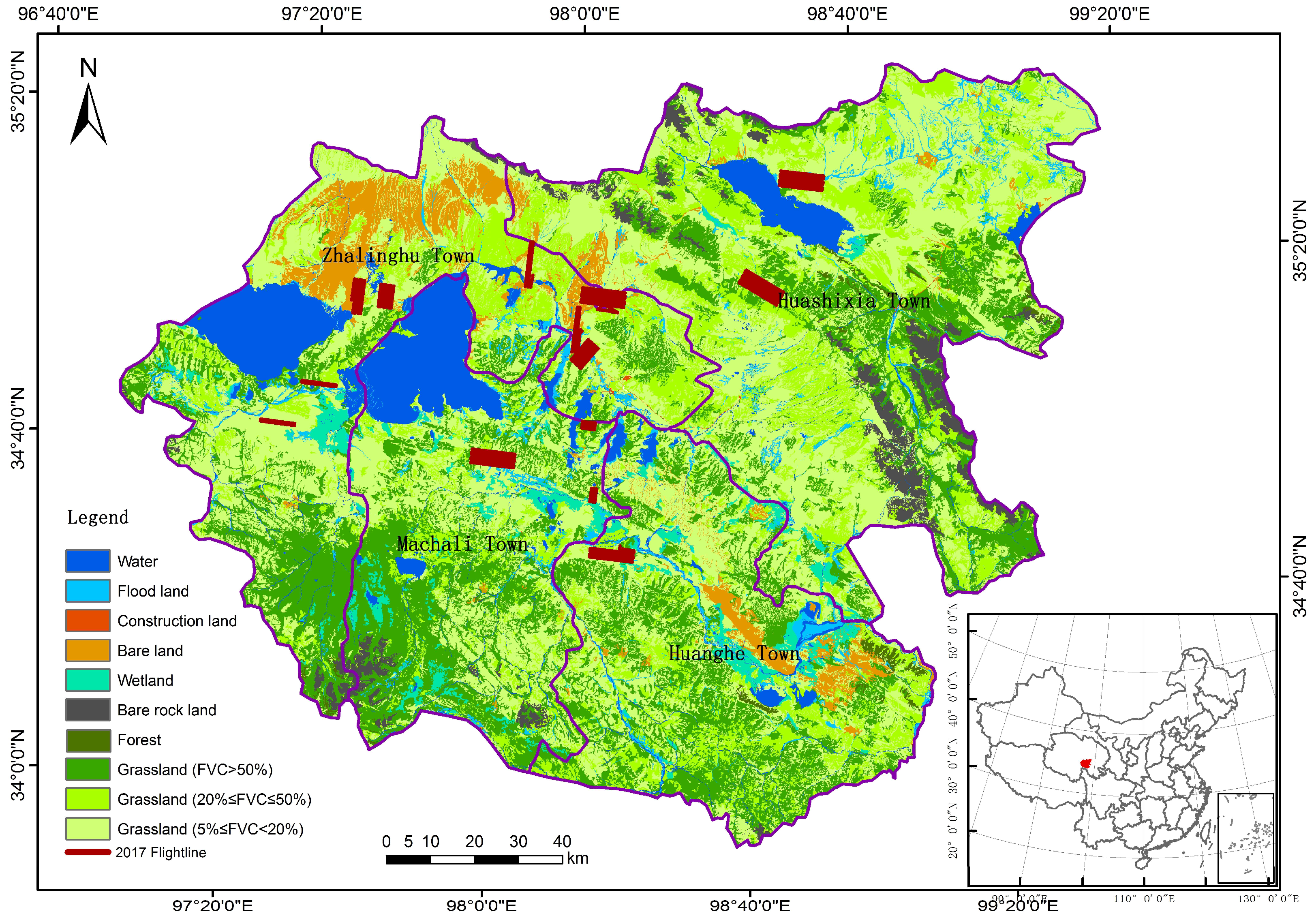
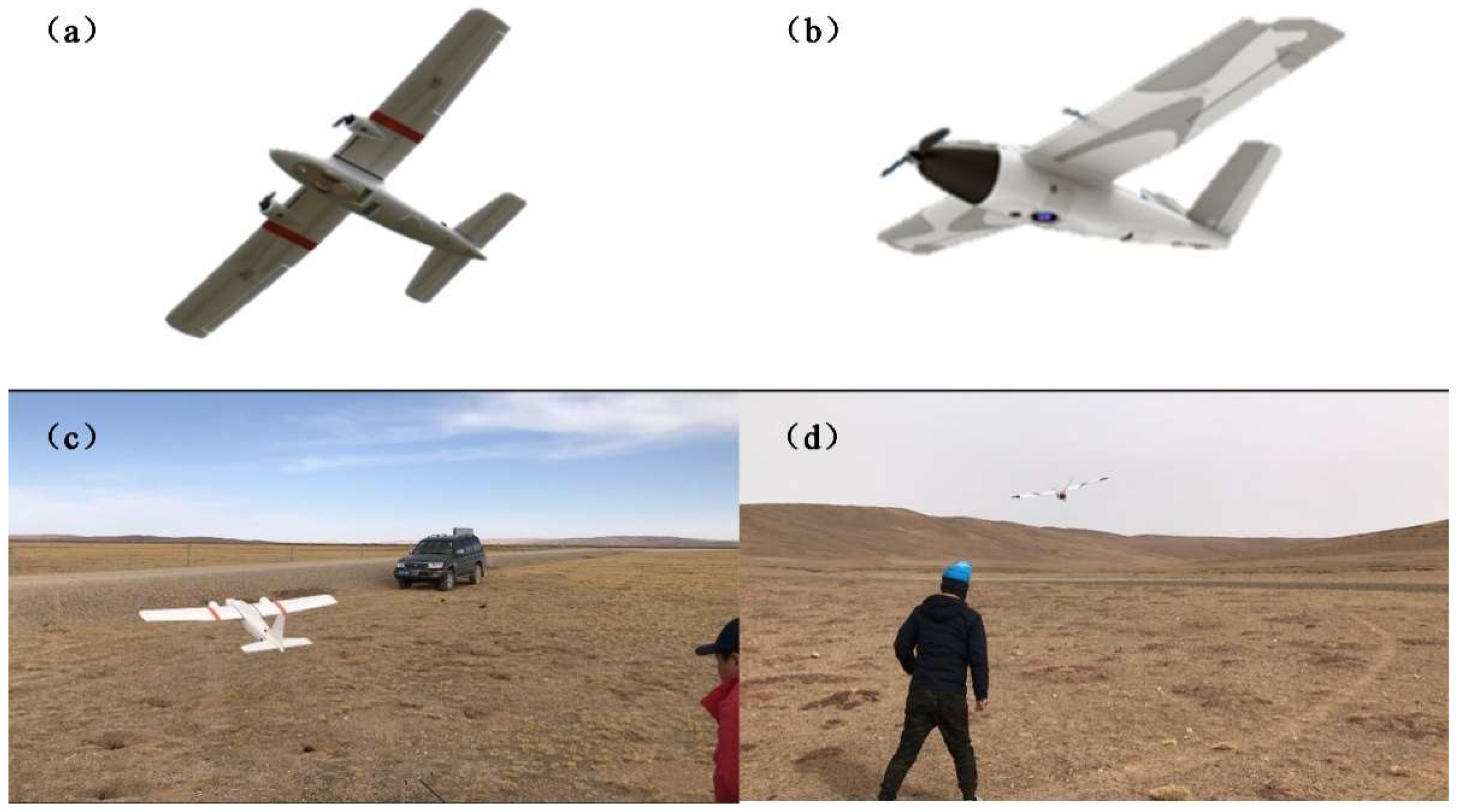
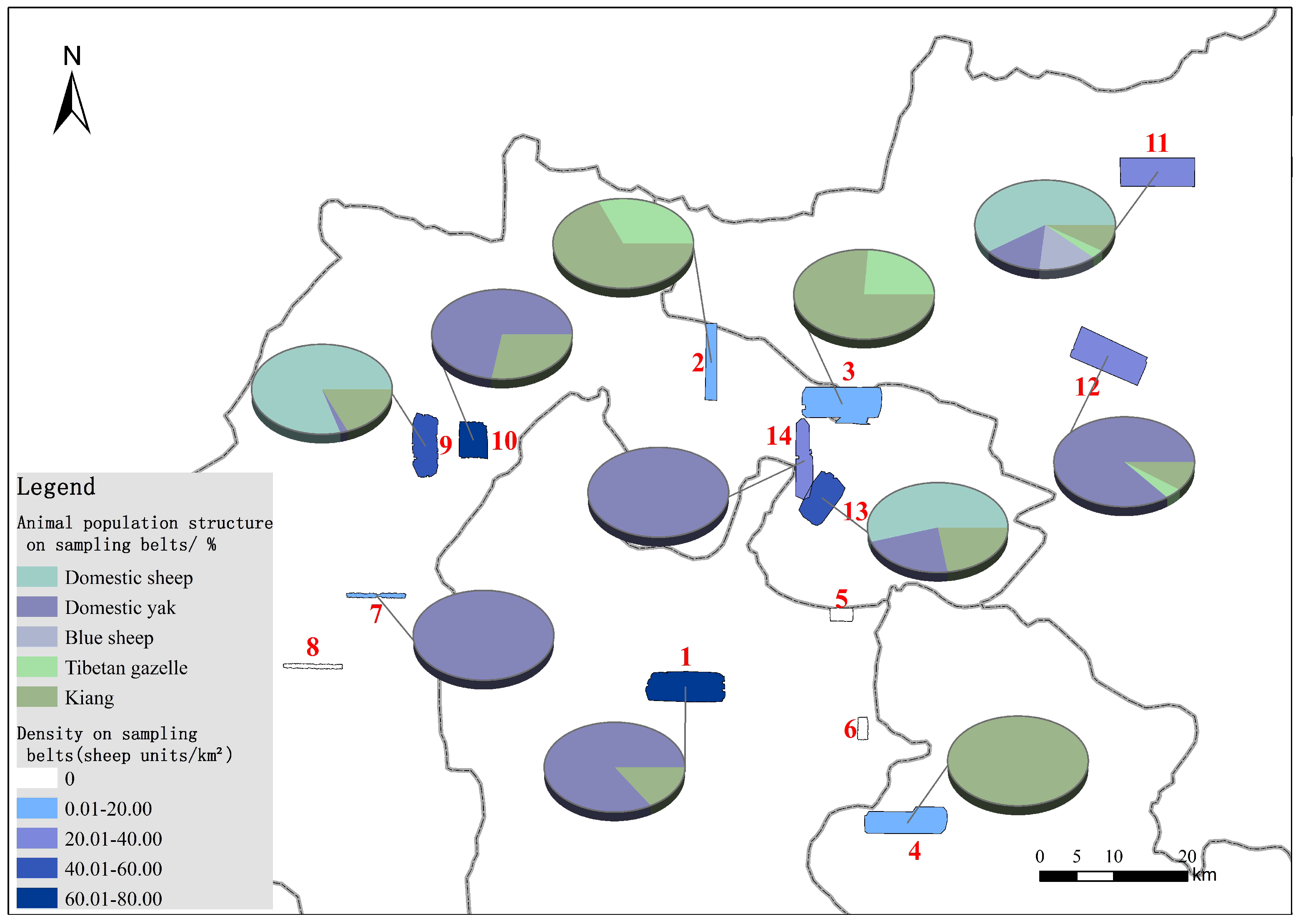
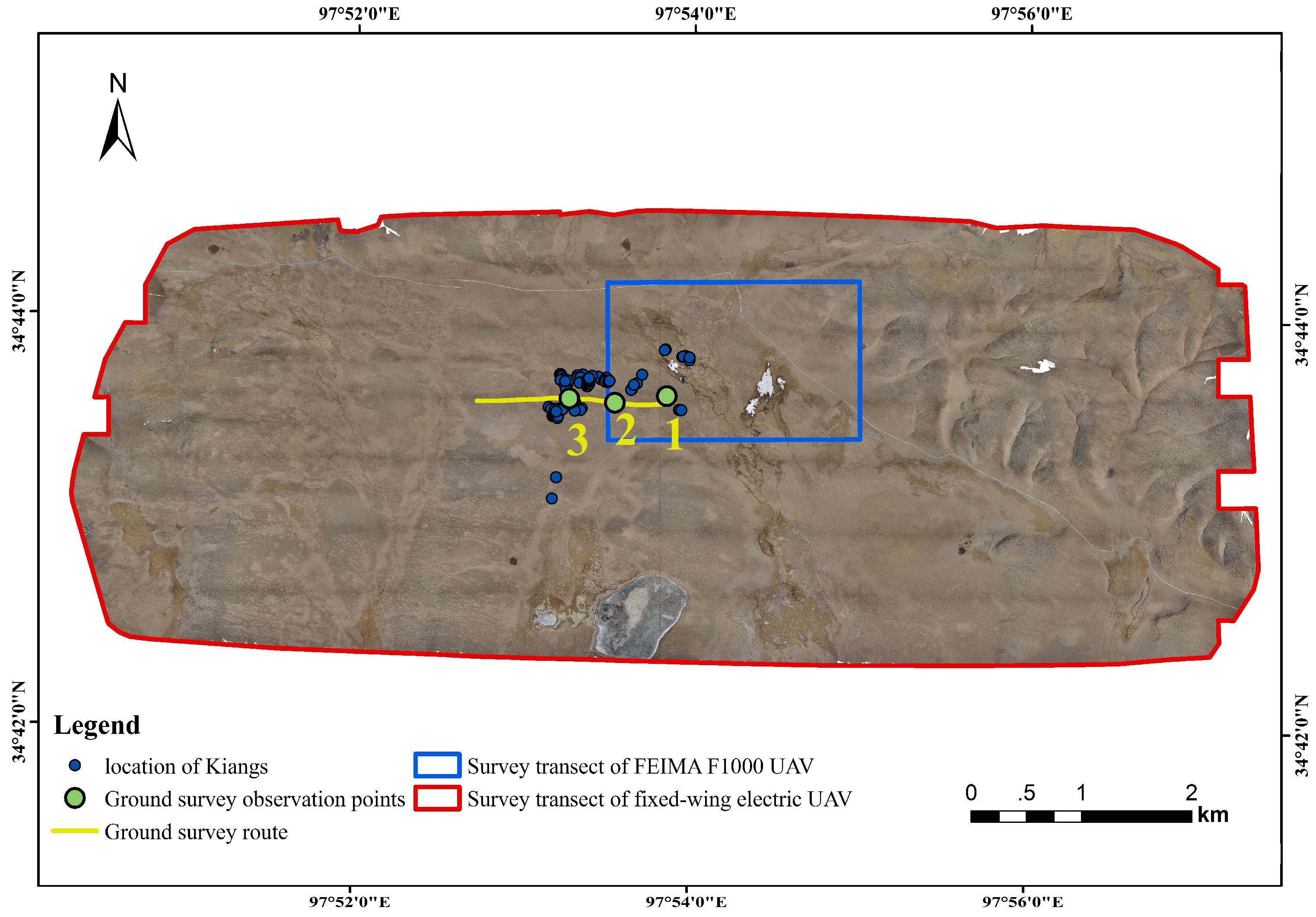
| Parameter | Fixed-Wing Electric UAV | FEIMA F1000 UAV |
|---|---|---|
| Span | 1.6 m | 1.6 m |
| Payload | 0.5 kg | 1.0 kg |
| Maximum Takeoff Weight | 3 kg | 3 kg |
| Engine | electrical | electrical |
| Battery Life | 90 min | 60 min |
| Speed | 72 km/h | 60 km/h |
| Camera Model | ILCE-5100 | ILCE-5100 |
| Number of Integrated Cameras | 2 (Angle of 130°, overlap of 50%) | 1 |
| Focal length | 30 mm | 30 mm |
| Pixel | 6000 × 4000 | 6000 × 4000 |
| Relative Altitude of Flight | 250 m | |
| Number of survey samples | 14 | |
| Image Amounts | 23,784 | |
| Total Aerial Area | 350 km2 | |
| Effective Aerial Area | 326.6 km2 | |
| Setting Resolution | 5 cm | |
| Actual Resolution | 4–7 cm | |
| Front overlap | 80% | |
| Side overlap | 60% | |
| Kiang | Tibetan Gazelle | Blue Sheep | Domestic Yak | Domestic Sheep | |
|---|---|---|---|---|---|
| Tone | Smoke brown, ochre brown | Earthy yellow, yellowish brown, grayish yellow | Steel gray, gray | Black, dark gray | White, off-white |
| Color | The main body is smoke brown, ochre brown, with edges in white and brown black. | The main body is earthy yellow, yellowish brown and grayish yellow, with tail end in white. | Body can be steel gray, gray and dirty white. | The main body is black, gray black and white. | The main body is black, dirty white and white. |
| Texture | The brown longitudinal strips in the center of back, and splicing texture of white patches at edges of the limbs and body side. | It is earthy yellow or solid color of similar color, with white patches on hips. | Gradients from steel gray to gray white. | Solid color or solid block splicing texture. | Solid color or solid block splicing texture. |
| Shadow | It has shadows with clear border (except for photos at cloudy day or noon), the shadows of head and face, neck longer than other animals. | Shadows with clear border (except for photos at cloudy day or noon). | Shadows with clear border (except for photos at cloudy day or noon). | Shadows with clear border (except for photos at cloudy day or noon). | Shadows with clear border (except for photos at cloudy day or noon). |
| Size | An adult Kiang has body length between 1.6 m–2.3 m. With aerial photos of resolution 4 cm, the individual lengths are 40–60 pixels. Immature Kiang is smaller but not alone. | An adult Tibetan gazelle has body length between 0.8 m–1.0 m. By taking 4 cm resolution as an example, the individual lengths mostly range from 20–30 pixels. | Adult blue sheep have a body length between 1.2 m and 1.4 m. With aerial photos of resolution 4 cm, the individual lengths are 25–35 pixels. | Adult domestic yak has a body length between 1.6 m and 2.2 m. With aerial photos of resolution 4 cm, the individual lengths are 40–50 pixels. Juvenile yaks can be as small as 0.8 m, but will not be alone. | Adult domestic sheep has a body length between 1.2 m and 1.5 m. With aerial photos of resolution 4 cm, the individual lengths are 25–35 pixels. Juvenile sheep can be as small as 0.4 m, but will not be alone. |
| Shape | The overall shape is approximate to the long strip and bulk or long handle and long circle. Length-width ratio is 4:1–5:1. | The overall shape is approximate to the long oval or rod-like. Length-width ratio is 3:1–5:1. | The overall shape is nearly oval. Length-width ratio is 3:1–4:1. | The overall shape is approximate to the long oval or rectangle. Length-width ratio is 1.5:1–3:1. | The overall shape is approximate to the long oval or water drop-shaped. Length-width ratio is 1.5:1–3:1. |
| Layout | Mostly distribute in groups, a small number of individuals live alone. | Live in Group or alone. | Mostly live in groups. | Mostly distribute in groups, often with objects and traces of human activities in the neighborhood. | Mostly distribute in groups, often with objects and traces of human activities in the neighborhood. |
| Group | 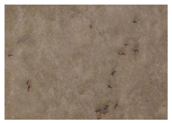 |  | 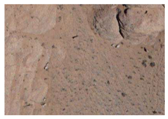 | 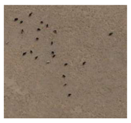 | 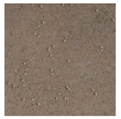 |
| Individual recognition example | 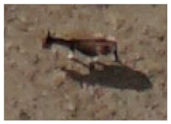 |  |  |  | 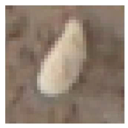 |
| Sectional view | 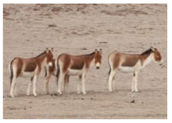 | 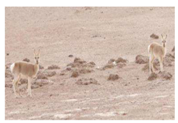 | 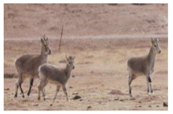 |  |  |
| Animal Species | Sheep Units |
|---|---|
| Kiang | 4 |
| Tibetan gazelle | 0.5 |
| Blue sheep | 1 |
| Domestic yak | 4 |
| Domestic sheep | 1 |
| Animal Species | Population in Transects | Density in Transects/km2 | Sheep Units |
|---|---|---|---|
| Kiang | 378 | 1.15 | 1512 |
| Tibetan gazelle | 199 | 0.61 | 99.5 |
| Blue sheep | 203 | 0.62 | 203 |
| Domestic yak | 1351 | 4.12 | 5404 |
| Domestic sheep | 2405 | 7.34 | 2405 |
| Total | 4536 | — | 9623.5 |
| Methods | Direct Extrapolation | Extrapolation after Deducting Non-Vegetated Areas | Estimations Based on Seasonal Meadows | Estimations Based on Elevation Zones | Estimations Based on Vegetation Type | |
|---|---|---|---|---|---|---|
| Estimations by the UAV survey in spring, 2017 | Domestic yak | 104,236 | 93,557 | 70,846 | 76,841 | 75,116 |
| Domestic sheep | 185,702 | 166,398 | 102,194 | 390,257 | 108,919 | |
| Conversion of livestock population at the end of 2016 | Domestic yak | 80,182 | 71,967 | 54,497 | 59,108 | 57,782 |
| Domestic sheep | 142,848 | 127,998 | 78,611 | 300,198 | 83,784 | |
| Deviations of conversion with livestock number records at the end of 2015 | Domestic yak | +35.36% | +21.49% | −8.00% | −0.21% | −2.45% |
| Domesticsheep | +95.33% | +75.02% | +7.49% | +310.48% | +14.56% | |
| Animal Species | Meadow Type | Density in Transects/km2 | Estimations of Population in Maduo County | 104 Sheep Units |
|---|---|---|---|---|
| Kiang | Meadows in cold seasons | 1.71 | 15552 | 6.22 |
| Meadows in warm seasons | 0.12 | 1557 | 0.62 | |
| total | 0.77 | 17109 | 6.84 | |
| Tibetan gazelle | Meadows in cold seasons | 0.53 | 4802 | 0.24 |
| Meadows in warm seasons | 0.85 | 11159 | 0.56 | |
| total | 0.72 | 15961 | 0.80 | |
| Blue sheep | Meadows in cold seasons | 0.91 | 8286 | 0.83 |
| Meadows in warm seasons | 0.08 | 1038 | 0.10 | |
| total | 0.42 | 9324 | 0.93 |
© 2018 by the authors. Licensee MDPI, Basel, Switzerland. This article is an open access article distributed under the terms and conditions of the Creative Commons Attribution (CC BY) license (http://creativecommons.org/licenses/by/4.0/).
Share and Cite
Guo, X.; Shao, Q.; Li, Y.; Wang, Y.; Wang, D.; Liu, J.; Fan, J.; Yang, F. Application of UAV Remote Sensing for a Population Census of Large Wild Herbivores—Taking the Headwater Region of the Yellow River as an Example. Remote Sens. 2018, 10, 1041. https://doi.org/10.3390/rs10071041
Guo X, Shao Q, Li Y, Wang Y, Wang D, Liu J, Fan J, Yang F. Application of UAV Remote Sensing for a Population Census of Large Wild Herbivores—Taking the Headwater Region of the Yellow River as an Example. Remote Sensing. 2018; 10(7):1041. https://doi.org/10.3390/rs10071041
Chicago/Turabian StyleGuo, Xingjian, Quanqin Shao, Yuzhe Li, Yangchun Wang, Dongliang Wang, Jiyuan Liu, Jiangwen Fan, and Fan Yang. 2018. "Application of UAV Remote Sensing for a Population Census of Large Wild Herbivores—Taking the Headwater Region of the Yellow River as an Example" Remote Sensing 10, no. 7: 1041. https://doi.org/10.3390/rs10071041
APA StyleGuo, X., Shao, Q., Li, Y., Wang, Y., Wang, D., Liu, J., Fan, J., & Yang, F. (2018). Application of UAV Remote Sensing for a Population Census of Large Wild Herbivores—Taking the Headwater Region of the Yellow River as an Example. Remote Sensing, 10(7), 1041. https://doi.org/10.3390/rs10071041






